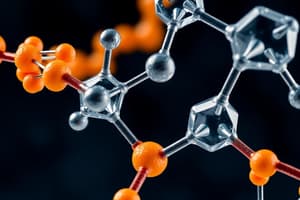Podcast
Questions and Answers
What is the definition of lipids?
What is the definition of lipids?
Named for the Greek word lipos, which means 'fat.' A heterogenous group of biomolecules that contain fatty acids or a steroid nucleus.
What are the major functions of lipids?
What are the major functions of lipids?
- Major source of energy
- Storage form of energy
- Components of cell membranes
- All of the above (correct)
What are essential fatty acids?
What are essential fatty acids?
Fatty acids that are necessary for the body but cannot be synthesized by it.
Lipids are water soluble.
Lipids are water soluble.
Which of the following vitamins are fat-soluble?
Which of the following vitamins are fat-soluble?
What is the primary role of adipose tissue?
What is the primary role of adipose tissue?
What are lipoproteins responsible for?
What are lipoproteins responsible for?
Fatty acids are obtained by the hydrolysis of ______.
Fatty acids are obtained by the hydrolysis of ______.
What is a saturated fatty acid?
What is a saturated fatty acid?
What suffix is used for naming saturated fatty acids?
What suffix is used for naming saturated fatty acids?
What is the significance of cholesterol in the body?
What is the significance of cholesterol in the body?
Flashcards are hidden until you start studying
Study Notes
Lipids: Definition and Functions
- Lipids are a diverse group of biomolecules that share the common characteristic of being hydrophobic (water-insoluble) and soluble in organic solvents.
- They are named after the Greek word "lipos," meaning "fat."
- Lipids consist of fatty acids or a steroid nucleus.
- They play crucial roles in the body:
- Providing energy (triglycerides are the storage form)
- Forming structural components of cell membranes
- Serving as hormones (e.g., steroid hormones like cortisol, aldosterone, and sex hormones)
- Acting as fat-soluble vitamins with regulatory functions
Biological Significance of Lipids
- Lipids are a significant source of energy in our diet and within the body.
- They are stored as triglycerides in adipose tissue, which also provides insulation and organ protection.
- Lipids are essential components of nervous tissue, contributing to its function in sensation and response.
- They are transported in the blood as lipoproteins, which are crucial for delivering lipids and vitamins to cells.
- Cholesterol plays a vital role in the synthesis of hormones, vitamin D3, bile salts, and sterols.
- Prostaglandins, derived from lipids, influence blood pressure and are linked to arteriosclerosis.
- Lipids serve as a valuable source of essential fatty acids, such as linoleic acid, linolenic acid, and arachidonic acid, which the body cannot synthesize on its own.
- They can act as activators for certain enzymes and participate in electron transport within mitochondria.
Classification of Lipids
- Lipids are grouped into three main categories:
- Simple lipids: Esters of fatty acids with alcohols (e.g., triglycerides, also known as fats or oils)
- Conjugated (complex) lipids: Esters of fatty acids with alcohols and additional groups (e.g., phospholipids, glycolipids, lipoproteins, waxes)
- Derived lipids: Products obtained by hydrolysis of simple or complex lipids (e.g., fatty acids, cholesterol, ketone bodies)
Fatty Acids
- Fatty acids are produced by hydrolyzing neutral fats (triglycerides).
- They are organic monocarboxylic acids with an aliphatic chain ranging from 4 to 24 carbon atoms.
- Insoluble in water and soluble in organic solvents.
- The aliphatic chain can be saturated (no double bonds) or unsaturated (containing one or more double bonds).
- Serve as fuel, building blocks for triglycerides, phospholipids, and sphingolipids.
- Precursors for prostaglandins.
Nomenclature of Fatty Acids
- Fatty acids are typically written using condensed structural formulas or skeletal formulas.
- Naming follows a systematic approach:
- The base name is derived from the corresponding hydrocarbon with the same number of carbon atoms, replacing the final "-e" with "-oic acid".
- Saturated fatty acids end with "-anoic acid" (e.g., octanoic acid).
- Unsaturated fatty acids end with "-enoic acid" (e.g., octadecenoic acid).
- Carbon atoms are numbered from the -COOH group.
- The carbon atom adjacent to the -COOH group is called the α-carbon atom.
- For example, octadecenoic acid (oleic acid) is written as 18:1, 9, indicating an 18-carbon chain with one double bond between carbon atoms 9 and 10.
Studying That Suits You
Use AI to generate personalized quizzes and flashcards to suit your learning preferences.




